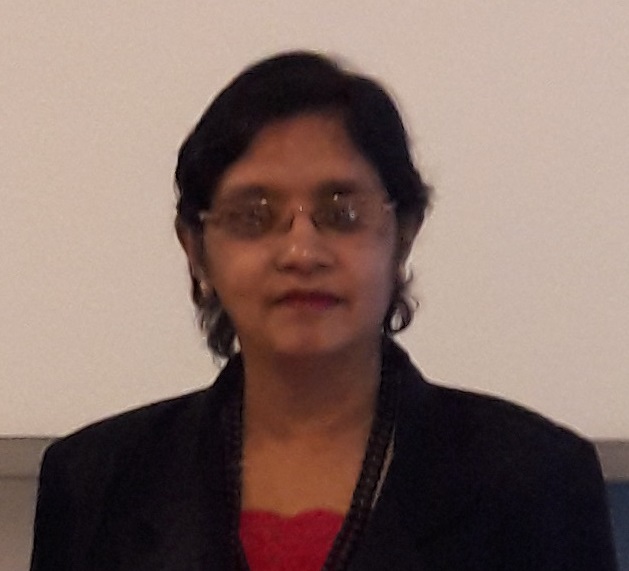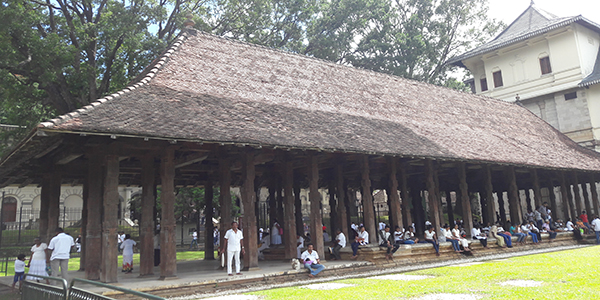Audience Hall Kandy – location of a historic event
By Arundathie Abeysinghe
 Located between Dalada Maligawa (Temple of the Sacred Tooth Relic) and Royal Palace of Kandy, the Audience Hall also known as Magul Maduwa (in Sinhala) or Assembly Hall, the place where the Kandyan Kings had held courts during the Kandyan Kingdom (where Kandyan Kings met their ministers). The Audience Hall had also been used for cultural as well as religious purposes during the Kandyan Kingdom. The Hall was also known as “Maha Naduwa” or Royal Court by locals as the building was used by the King as the courts. During the Kandyan Kingdom, the King had met Ambassadors from different countries in this hall for official purposes, exchanged official documents (between *Ceylon and foreign countries), gifts as well as discussions had been held between the King, his Senior Officers and Ambassadors.
Located between Dalada Maligawa (Temple of the Sacred Tooth Relic) and Royal Palace of Kandy, the Audience Hall also known as Magul Maduwa (in Sinhala) or Assembly Hall, the place where the Kandyan Kings had held courts during the Kandyan Kingdom (where Kandyan Kings met their ministers). The Audience Hall had also been used for cultural as well as religious purposes during the Kandyan Kingdom. The Hall was also known as “Maha Naduwa” or Royal Court by locals as the building was used by the King as the courts. During the Kandyan Kingdom, the King had met Ambassadors from different countries in this hall for official purposes, exchanged official documents (between *Ceylon and foreign countries), gifts as well as discussions had been held between the King, his Senior Officers and Ambassadors.
Many key events had taken place at this historic location, the major event being the signing of the *Kandyan Convention.
The British had served death sentence to Sri Lankan patriots *Madugalle Disawe and *Keppatipola Disawe at this hall.
Construction of the Hall was commenced by King Sri Rajadhi Rajasinghe (1779 -1797) in 1783, but it could not be completed during his regime and it was completed during the reign of King Sri Wickrema Rajasinghe (1798-1815).
Intricately carved wooden pillars of the roof and wooden pillars in the Hall belong to the Kandyan Period.
- D. M. Waidyasekera in his book ‘Great Royal Artificer of the Kandyan Kingdom – Devendra Mulachari’ (page 134), (research study of the life and work of one of the brilliant artificers and designers during the Kandyan Kingdom) has described about Devendra Mulachari, the brilliant artificer of the Audience Hall.
According to Ananda Coomaraswamy’s ‘Medieval Sinhalese Art’, ‘The names of artificers are not recorded in their work nor as a rule remembered except by their own descendants’ (P. 59). Hence, except in recent works, names of great artificers are rarely mentioned in literary works of yesteryear.
During the early days of British Colonial Era, British Missionaries had used the Audience Hall as a church building for conversion process.
Reverand Reginald Herber, Lord Bishop of Calcutta has described about a sermon held in the Audience Hall in his book ‘Narrative of a Journey through the Upper Provinces in India’ published in 1829;
“…Early this morning the Bishop held a confirmation; there were seven native candidates, and twenty Europeans; and he afterwards preached at the usual time of morning service. There is no church, but the Hall of Audience, where the Kings of Candy held their courts, is used as such; it is a long room, of which the wooden pillars, having the lotus carved on their capitals, are the only ornamental parts remaining. It was a most interesting and affecting sight, to see Christian worship performed, and a Christian bishop blessing his congregation, a part of which was native, in the very spot where the most cruelties were exercised not more than ten years ago. How little could such an event at that time have been contemplated! …”
The present day structure is an extension to the original structure done by British in 1872 to host the visit of Prince Albert Edward, Prince of Wales. According to legends, the British had taken 32 wooden columns from “Palle Vasale” (Queen’s living quarters during the Kandyan Kingdom) and replaced them with brick pillars and 16 pillars had been used for the Audience Hall. Although, renovations were carried out, the British had preserved the original outlook of the Hall without harming its architecture.

At present, it is conserved under the Department of Archaeology.
Location: Between Temple of the Sacred Tooth Relic and Royal Palace of Kandy
- Ceylon – Sri Lanka gained Independence from British Colonials in 1948. In 1972, Ceylon became a republic within the Commonwealth and Ceylon was thereafter known as Sri Lanka.
- Kandyan Convention – The agreement that was signed on March 2, 1815 between Kandyan Chieftains (Radalas in Sinhala) of Kandyan Kingdom and the British for the deposition of King Sri Wickrema Rajasinghe (1798-1815), the last monarch of the Kandyan Kingdom as well as Sri Lanka. With the signing of the Convention, Kandyan Kingdom as well as entire *Ceylon was ceded to British Rule.
- Keppetipola Disawe – Sri Wickramarajasinghe Udagabada Nilame Madugalle known as Keppetipola Disawe was a high ranking official who served King Sri Wickrema Rajasinghe as well as the British Administration. He was a prominent leader of *Uva Rebellion of 1818 (the British sent him to suppress the rebels). The Rebellion was defeated by the British and Keppetipola Disawe was found guilty along with Madugalle Disawe and several other leaders as he supported the rebels. He is popular among locals for the exceptional courage he displayed at the moment of his execution. He is honored as a national hero of Sri Lanka.
- Madugalle Disawe – Sri Wickramrajasinghe Udagabada Nilame Madugalle known as Madugalle Disawe was a high ranking official who served King Sri Wickrema Rajasinghe as well as the British Administration. He was a prominent leader of *Uva Rebellion of 1818 (the British sent him to suppress the rebels). The Rebellion was defeated by the British and Madugalle Disawe was found guilty as he supported the rebels.
- Uva Rebellion – Uwa Wellessa Great Rebellion of 1818 (1817 October – 1818 November) known among locals as Uva Rebellion of 1818 was the third Kandyan War with the British, The Rebellion is known by the two places – Uva and Wellassa in *Uva Province, a territory that belonged to Kandyan Kingdom. The Rebellion was organized against British Colonial Rule.
- Uva Province – Fourth largest province in Sri Lanka bordered by Central, Eastern and Southern provinces.







